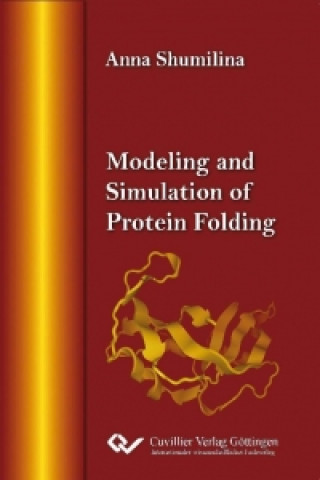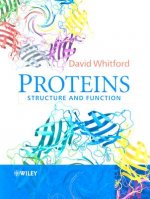
Kód: 12738733
Modeling and Simulation of Protein Folding
Autor Anna Shumilina
The book describes a new mathematical model for intracellular protein folding and the implementation of this model in the form of a novel simulation software. Besides, the related biological, chemical, and physical background, imp ... celý popis
- Jazyk:
 Angličtina
Angličtina - Väzba: Brožovaná
- Počet strán: 218
Nakladateľ: Cuvillier Verlag, 2011
- Viac informácií o knihe

Mohlo by sa vám tiež páčiť
-

Ultimate Protein Powder Cookbook
26.64 € -9 % -

Proteins - Structure and Function
80.33 € -

No Easy Day
17.79 € -14 % -

A Brief History of Wyandot County, Ohio
24.53 € -2 % -

Civil War Ghosts of Central Georgia and Savannah
22.01 € -

Alternative Modernities in French Travel Writing
147.51 € -

Michael Jackson - Gercek Hikaye
16.28 €
Darčekový poukaz: Radosť zaručená
- Darujte poukaz v ľubovoľnej hodnote, a my sa postaráme o zvyšok.
- Poukaz sa vzťahuje na všetky produkty v našej ponuke.
- Elektronický poukaz si vytlačíte z e-mailu a môžete ho ihneď darovať.
- Platnosť poukazu je 12 mesiacov od dátumu vystavenia.
Viac informácií o knihe Modeling and Simulation of Protein Folding
Nákupom získate 127 bodov
 Anotácia knihy
Anotácia knihy
The book describes a new mathematical model for intracellular protein folding and the implementation of this model in the form of a novel simulation software. Besides, the related biological, chemical, and physical background, important for understanding and rationalization of the proposed model, is outlined, and a short overview of the best-known methods for protein structure prediction and molecular modeling is given.The first chapter provides a general introduction to the problem, characterizes the chemical structure of proteins, and summarizes amino acid properties, including chirality and ionization behavior. After that, the principles of quantum mechanics and their consequences for the molecular structure are described. The discussion goes over to covalent and hydrogen bonding, as well as to electrostatic and van der Waals interactions. Further, some known facts about the three-dimensional structure of proteins and typical conformations of amino acids are outlined, followed by a quick glance at the hydrophobic effect and the interaction of charged groups with the solvent. Later on the focus is shifted to biological aspects, starting with chaperons and assisted protein folding, mentioning prions, which put into question the popular hypothesis about the global energy minimum of any native structure, and continuing with details of protein synthesis in the cell, which constituted the basis for the proposed model. The chapter finishes with a short description of experimental methods for protein structure prediction and with some information about databases for storage of known protein structures.The second chapter starts with a short overview of the knowledge-based protein structure prediction and ab initio protein folding approaches, then continues with empirical molecular mechanics force fields, typically used for molecular modeling. After that, it describes computation of atomic partial charges with a focus on the procedure of J. Gasteiger and M. Marsili, and proceeds with some models for hydrogen bonding. The chapter ends with a discussion about implicit solvation models.The third chapter describes the new modeling approach and some mathematical theory developed in relation to it. The idea of the model is to simulate a process resembling intracellular cotranslational folding. An attachment of a new residue is performed in a way that the formed peptide group is disposed in the trans conformation, and only the chain twisting about certain single bonds is allowed. Transitions with an energy increase are permitted to a limited extent. Beside the electrostatic and van der Waals interactions, the proposed model incorporates hydrogen and disulfide bonding, solvation effects, and dielectric screening at the protein surface. A general expression connecting interatomic distances and dihedral angles is derived, which resulted in a formulation of the model in the space of molecular torsion angles. Twisting forces are computed analytically and utilized for the improvement of computational efficiency the folding simulations. Besides, equations for dynamics in the space of torsion angles are derived, and a conclusion related to folding pathways is drawn.The last chapter discusses some non-technical details related to the implementation of the proposed model, including a number of developed algorithms, and the resulting simulation software. The chapter ends with a short discussion of simulation results and with an outlook.This book is aimed in the first place to biophysicists and bioinformaticians, but can be also interesting for theoretical chemists, mathematicians, and molecular biologists, since it includes a broad interdisciplinary overview accompanied by unique visualizations, which were performed with the help of the simulation software developed by the author.
 Parametre knihy
Parametre knihy
50.47 €
- Celý názov: Modeling and Simulation of Protein Folding
- Autor: Anna Shumilina
- Jazyk:
 Angličtina
Angličtina - Väzba: Brožovaná
- Počet strán: 218
- EAN: 9783869557984
- ISBN: 3869557982
- ID: 12738733
- Nakladateľ: Cuvillier Verlag
- Hmotnosť: 289 g
- Rozmery: 210 × 148 × 13 mm
- Dátum vydania: 22. June 2011
Obľúbené z iného súdka
-

Dune
9.54 € -21 % -

Haunting Adeline
30.56 € -

Berserk Deluxe Volume 2
51.68 € -

White Nights
3.51 € -23 % -

Powerless
12.56 € -1 % -

Atomic Habits
15.98 € -14 % -

Dune Messiah
11.25 € -

Berserk Deluxe Volume 3
53.08 € -

One Day
10.55 € -11 % -

Berserk Deluxe Volume 1
51.58 € -

Iron Flame
16.18 € -18 % -

Surrounded by Idiots
10.05 € -15 % -

Harry Potter and the Prisoner of Azkaban (Minalima Edition)
41.52 € -

Gravity Falls Journal 3
21.71 € -

Heaven Official's Blessing: Tian Guan Ci Fu (Novel) Vol. 1
21.61 € -

The Creative Act
25.93 € -5 % -

Dune
12.36 € -13 % -

Hunting Adeline
30.76 € -

A Little Life
17.49 € -

Children of Dune
11.35 € -

Heaven Official's Blessing: Tian Guan Ci Fu (Novel) Vol. 2
20.10 € -4 % -

Bungo Stray Dogs, Vol. 8 (light novel)
15.98 € -

Percy Jackson and the Olympians 5 Book Paperback Boxed Set
45.24 € -

Solo Leveling, Vol. 1
21.41 € -

The Prisoner's Throne
11.55 € -2 % -

Court of Thorns and Roses
9.44 € -20 % -

Cry Baby Coloring Book
11.55 € -

Fourth Wing
19.10 € -2 % -

Icebreaker
9.84 € -11 % -

Berserk Deluxe Volume 6
53.08 € -

Avatar, the Last Airbender: The Kyoshi Novels (Box Set)
41.22 € -

The 48 Laws of Power
26.03 € -2 % -

House of Leaves
30.26 € -

Twisted Lies
9.74 € -17 % -

Dune Messiah
12.86 € -3 % -

No Longer Human
13.16 € -7 % -

48 Laws Of Power
17.18 € -13 % -

Twisted Games
9.34 € -21 % -

Caraval Paperback Boxed Set
42.73 € -

Solo Leveling, Vol. 2
20.81 € -7 % -

Open Circuits
41.22 € -

Berserk Deluxe Volume 5
51.27 € -2 % -

Heaven Official's Blessing: Tian Guan Ci Fu (Novel) Vol. 3
16.88 € -19 % -

Berserk Deluxe Volume 4
49.97 € -4 % -

Court of Mist and Fury
9.34 € -18 % -

SOLO LEVELING V08
21.51 € -

English File Upper Intermediate Multipack A (4th)
23.32 € -

CHAINSAW MAN V14
11.25 € -12 % -

Before the Coffee Gets Cold
9.24 € -13 %
Osobný odber Bratislava a 2642 dalších
Copyright ©2008-24 najlacnejsie-knihy.sk Všetky práva vyhradenéSúkromieCookies



 21 miliónov titulov
21 miliónov titulov Vrátenie do mesiaca
Vrátenie do mesiaca 02/210 210 99 (8-15.30h)
02/210 210 99 (8-15.30h)